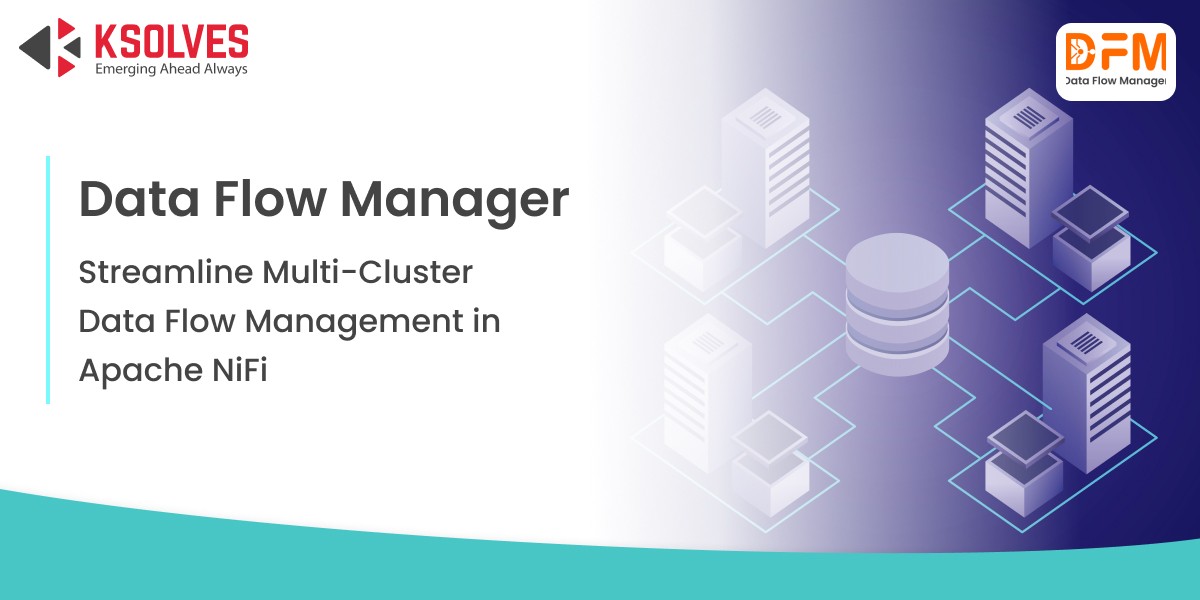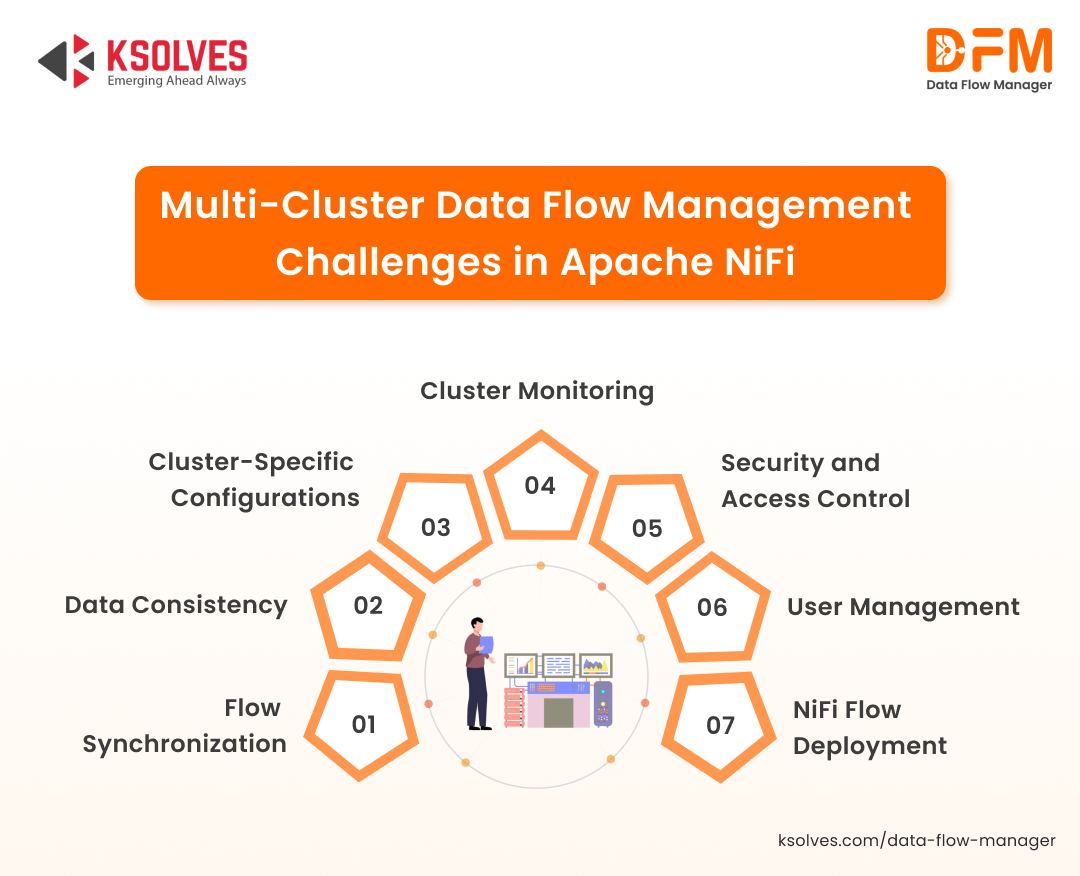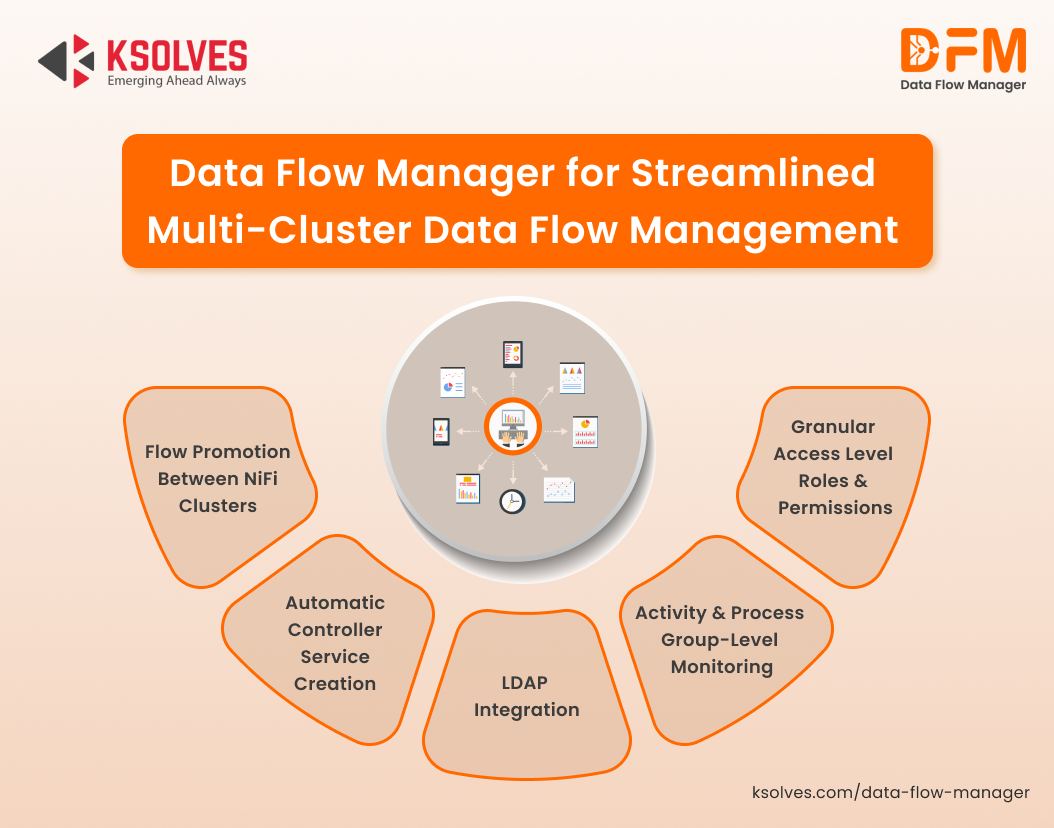The Challenges of Multi-Cluster Data Flow Management in Apache NiFi
![]()

Today, organizations are more inclined to multi-cluster environments as they scale at a greater pace. Three primary reasons for adopting multi-cluster environments are:
- Isolation: Organizations can leverage separate clusters for different workloads. Hence, any issue in one cluster does not affect other clusters in an environment.
- Availability: Organizations can achieve high availability with multiple clusters. If one of the clusters goes down or fails, they can route the workload to another cluster. This prevents disruptions to ongoing operations, reducing downtime.
- Scalability: Organizations can distribute workloads across multiple clusters and allocate new resources as required.
Apache NiFi, a data ingestion platform, is often used in multi-cluster environments. NiFi flows move across multiple clusters to accomplish specific tasks, such as transferring data between systems, processing and transforming data, etc. These clusters are typically development, staging, and production clusters.
Managing NiFi flows across these multiple clusters poses multiple challenges. Let us walk you through those challenges in this blog. Also, we will introduce you to a game-changing automation tool, Data Flow Manager, to address those challenges.

1. Ensuring Flow Synchronization and Consistency Across Clusters
As NiFi flows move across different clusters, it becomes challenging to keep them synchronized. Simply put, updating a NiFi flow in one cluster without mirroring it in other clusters leads to data inconsistency. This increases operational risks, as clusters may process data differently. Also, you may encounter unexpected errors or experience data loss.
2. Managing Cluster-Specific Configurations
Each cluster in a multi-cluster environment requires unique configurations, such as different security credentials, database connections, API endpoints, etc. If you set up these configurations manually, there is a high chance of errors, resulting in the application of incorrect configurations. As a result of this, NiFi flows may fail, data integrity issues may arise, or data security may compromise.
3. Monitoring and Troubleshooting Across Clusters
When NiFi flows span across multiple clusters, it becomes challenging to monitor their performance. Whether you need to identify the root cause of performance bottlenecks or failures and troubleshoot them, you need significant effort and time. This leads to slow issue resolution, resulting in downtime.
Many times, performance bottlenecks may go unnoticed due to the cumbersome nature of the monitoring process. This affects the overall performance.
4. Maintaining Security and Access Control
With the rising risk of data breaches, it becomes imperative to ensure secure data access and data flow between clusters. As a result, administrators must ensure that data in transit and at rest is encrypted and access controls are implemented.
Each cluster in a multi-cluster environment has different security requirements, compliance standards, and access policies. It is challenging for administrators to properly synchronize user authentication and role-based access across all clusters to prevent data leakage.
5. Managing Users of Different Roles
As the number of users and clusters grows, it becomes increasingly challenging to ensure that user roles are applied correctly across all clusters. As users have different levels of access to clusters or data flows, coordinating roles, privileges, and credentials across clusters becomes a key challenge.
This leads to administrative overhead and can create security risks with improper user management.
6. Deploying Flows Across Clusters
Manually deploying NiFi flows from one cluster to another is tedious, time-consuming, and error-prone. It may also increase the chance of configuration drift across clusters, leading to inconsistencies and unexpected behavior in production.
How Can Data Flow Manager Help?
Data Flow Manager, powered by NiFi and developed by Ksolves India Limited, is a UI-based tool that automates the deployment of NiFi flows across clusters. This no-code tool streamlines data flow management across Apache NiFi clusters.
Here’s how Data Flow Manager helps you address the above challenges of multi-cluster data flow management in Apache NiFi:
1. Flow Promotion Between NiFi Clusters
Data Flow Manager enables automated promotion of data flows between different NiFi clusters. This ensures that data flows are synchronized across environments like development, staging, and production.
By automating this process, our tool reduces the risks associated with manual flow deployments. It ensures that changes made in one cluster are consistently reflected in all others, minimizing errors.
2. Centralized User Management
Data Flow Manager simplifies user management by integrating with LDAP. This enables centralized control over user access across clusters. By syncing user credentials and roles across environments, it eliminates the complexity of managing user access separately for each cluster.
With Granular Access Level Roles & Permissions, our tool ensures that users have appropriate access to data flows and clusters. This leads to reduced administrative overhead and enhanced security.
3. Role-Based Access Control
Our tool offers granular access level roles & permissions. This enables fine-grained control over who can access specific NiFi flows, improving overall security by limiting access based on user responsibilities.
4. Monitoring and Optimization
Data Flow Manager provides activity & process group-level monitoring, giving users the ability to track and monitor the performance and activities of their NiFi flows at a granular level. This detailed monitoring helps identify issues early and optimize data flow performance.
Additionally, the Dashboard provides real-time insights into key performance indicators, allowing teams to make data-driven decisions and ensure that data flows are running efficiently across clusters.
5. Controller Service Automation
Data Flow Manager automates the creation of Controller Services, simplifying the process of managing these services within NiFi flows. This automation reduces the manual configuration required for each cluster, ensuring consistency and saving time during deployment and maintenance.
Watch the video now to see how Data flow Manager changes the game for data flow management.

Conclusion
Data Flow Manager provides comprehensive solutions to manage Apache NiFi flows across multi-cluster environments. From automating flow promotion and deployment schedules to enhancing security with LDAP integration and granular access control, this tool improves operational efficiency, ensures consistency, and simplifies multi-cluster management. With these features, organizations can better manage their data flows, optimize performance, and maintain secure and compliant operations across their NiFi clusters.
